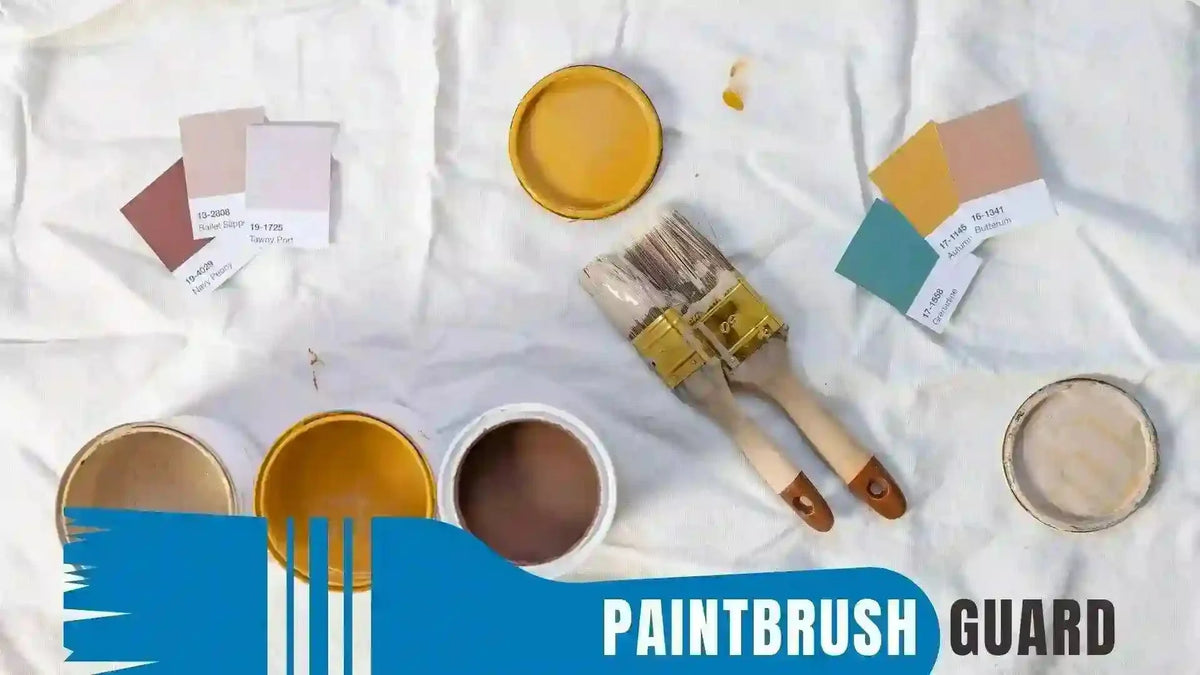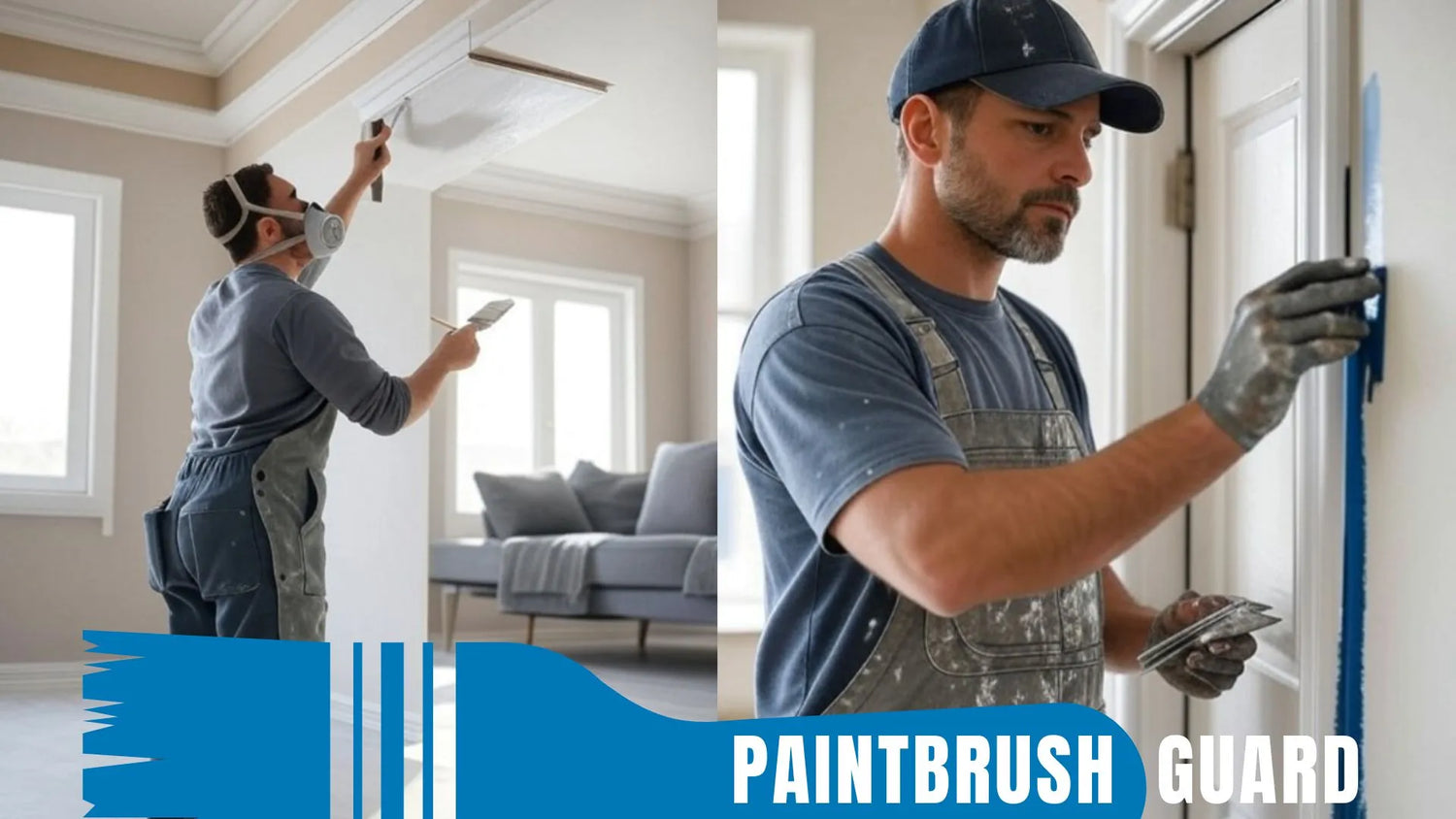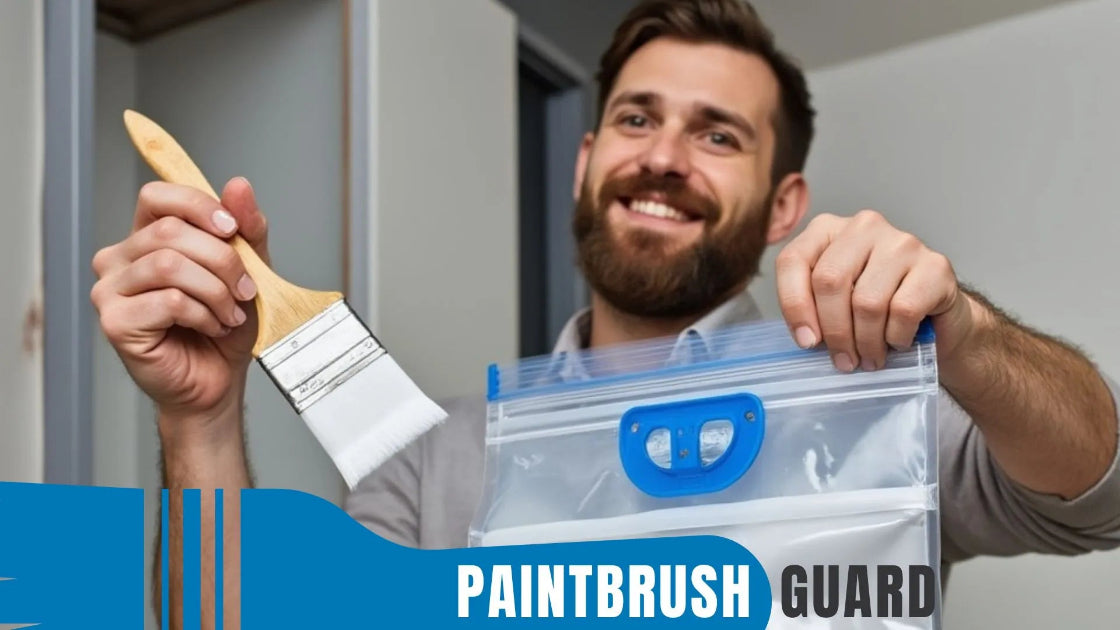
Mastering Paintbrush Techniques: Guide to Flawless Finishes
|
Time to read 16 min
|
Time to read 16 min
Painting a home is an art form, and the paintbrush is your tool to create a masterpiece, whether you’re refreshing a 12x12 room or tackling a 1,500-square-foot exterior.
But without the right techniques, you might end up with streaks, drips, or uneven finishes that detract from your hard work.
Paintbrush Guard has become a painter’s ally, keeping brushes ready between sessions and supporting eco-friendly practices.
This ultimate guide answers the top 20 questions about using a paintbrush effectively, offering techniques to achieve flawless results on walls, trim, cabinets, and more.
From avoiding streaks to painting detailed baseboards, these tips will help both pros and DIYers paint with precision, saving time and resources while ensuring every stroke is perfect, sustainably transforming your space.
With no cleanup required after a painting session, you can take a short break mid-project or wrap up your painting for the day, your brush stays ready without the need to clean.
To avoid streaks on walls, use a high-quality brush like a 2–3-inch angled sash brush and apply paint in smooth, overlapping strokes. Start by loading the brush lightly—dip just the bottom third into the paint, tapping off excess on the can’s rim.
Paint in long, even strokes, working in 2–3-foot sections, and feather the edges by lightly dragging the brush to blend wet paint, preventing visible lines.
Maintain a wet edge by working quickly, and avoid going over partially dried paint, which causes streaks. Paintbrush Guard keeps your brush wet between coats, saving 15–30 minutes per break, ensuring consistent application, a sustainable practice.
This technique minimizes waste by reducing rework, ensuring a smooth, streak-free finish that elevates your walls to a professional standard, perfect for any home painting project.
The best way to load a paintbrush with paint is to dip only the bottom third of the bristles into the paint, ensuring control and minimizing drips.
For a 2-inch brush, dip about ½ inch into the paint, then tap both sides gently on the inside of the can to remove excess—don’t wipe it on the rim, as this removes too much paint.
Paintbrush Guard keeps the loaded brush wet during breaks, saving 15–30 minutes per session, a sustainable choice, as it reduces the need to reload frequently, saving paint.
This technique prevents waste, ensures smooth strokes, and maintains consistency, allowing you to paint efficiently while keeping your project eco-friendly, with just the right amount of paint on your brush for every stroke.
For clean lines on trim, use a 1–2-inch angled sash brush and painter’s tape to mask off adjacent surfaces, taking 30–45 minutes for a 12x12 room. Load the brush lightly, dipping the bottom third into the paint, and tap off excess.
Hold the brush at a 45-degree angle to the trim, using the angled edge to create a sharp line, and paint in long, steady strokes, working in 1–2-foot sections to maintain control.
Feather the edges to blend strokes, avoiding buildup. Paintbrush Guard keeps your brush wet during breaks, saving 15–30 minutes per session, ensuring the brush stays soft for precision.
Remove tape while the paint is wet to avoid peeling, minimizing waste from touch-ups. This technique ensures crisp, clean lines on trim, giving your project a polished, professional look with eco-friendly efficiency.
To hold a paintbrush for better control, grip it like a pencil near the ferrule, between your thumb, index, and middle fingers, keeping your wrist relaxed. For a 2-inch brush, this allows precise movements, especially for tasks like cutting in during a 12x12 room project (30–45 minutes per coat).
Keep your pinky or ring finger lightly resting on the surface for stability, adjusting pressure to control the stroke. This grip minimizes fatigue and ensures even application.
This technique reduces errors, minimizing paint waste from mistakes, and ensures smooth, eco-friendly painting, giving you confidence in every stroke, whether you’re a pro or a DIYer tackling a home project.
Paintbrush Guard Benefits: Learn more about the benefits of Paintbrush Guard vacuum storage. Save time, reduce water waste, prevent chemical pollution and cut costs on supplies for house painting projects.
The best technique for painting with a brush is to use smooth, overlapping strokes with a high-quality 2–3-inch angled brush. Load the brush by dipping the bottom third into the paint, tapping off excess, and apply in long, even strokes, working in 2–3-foot sections.
Start from a dry area and work into the wet edge, feathering the strokes by lightly dragging the brush to blend, ideal for a 12x12 room project (4–6 hours).
Work quickly to maintain a wet edge, avoiding overlap on drying paint, which causes marks. This technique minimizes waste by reducing rework, delivering a smooth, professional finish while keeping your painting eco-friendly, perfect for walls, trim, or furniture.
To use a paintbrush for cutting in corners, choose a 1–2-inch angled sash brush for precision. Load the brush lightly, dipping the bottom third into the paint, and tap off excess.
Position the brush at a 45-degree angle to the corner, using the angled edge to paint a straight line along one wall, then the other, creating a clean “V” shape in the corner.
Work in small sections, blending strokes to avoid buildup. This technique ensures clean, sharp corners without overlap, minimizing waste from touch-ups, and keeps your painting eco-friendly, giving your project a professional edge with every precise stroke.
Learn more about Paintbrush Guard: This guide tackles the top 20 questions about storing paintbrushes, from quick breaks to long-term care, and even challenges like humid coastal areas.
To avoid brush marks when painting doors, use a 2-inch angled brush and apply paint in thin, even coats. Load the brush lightly, dipping the bottom third into the paint, and tap off excess.
Paint with the grain in long, smooth strokes, working in small sections, and feather the edges to blend wet paint, taking about 1–2 hours per door. Sand lightly between coats with 220-grit sandpaper for a smooth finish.
Work quickly to maintain a wet edge, avoiding overlap on drying paint, which causes marks. This technique minimizes waste by reducing rework, delivering a flawless, mark-free door finish while keeping your painting eco-friendly, perfect for a polished home update.
The best way to use a paintbrush on textured surfaces, like stucco or popcorn ceilings, is with a 3–4-inch flat brush for better coverage.
Load the brush by dipping the bottom half into the paint, tapping off excess, and use a stippling motion—dabbing the brush into crevices—followed by light, even strokes to smooth the finish, taking 4–6 hours for a 12x12 room ceiling.
Work in small sections to ensure even coverage, as textured surfaces soak up more paint. Paintbrush Guard keeps your brush wet during breaks, saving 15–30 minutes per session, a sustainable choice in 2025, maintaining bristle flexibility for consistent application.
This technique minimizes paint waste by ensuring thorough coverage, keeping your painting eco-friendly while achieving a uniform finish on challenging textured surfaces, enhancing your home’s look.
Paintbrush Guard: This article explores how Paintbrush Guard’s paintbrush vacuum storage reduces toxic waste and supports sustainable house painting practices, making it an essential tool for environmentally conscious painters tackling house painting projects.
To paint baseboards, use a 1–2-inch angled sash brush for precision. Tape off the floor and walls with painter’s tape, taking 30–45 minutes for a 12x12 room, and load the brush lightly, dipping the bottom third into the paint, tapping off excess.
Paint in long, smooth strokes along the grain, working in 1–2-foot sections, and feather the edges to avoid buildup, ensuring clean lines.
Work carefully to avoid drips on the floor, and remove tape while the paint is wet. This technique minimizes waste from touch-ups, ensuring a crisp, professional baseboard finish while keeping your painting eco-friendly, perfect for adding a polished touch to any room.
To paint around outlets, use a 1-inch angled sash brush for precision and first ensure safety by turning off the power. Remove the outlet cover, and tape off the outlet itself with painter’s tape, taking 10–15 minutes per outlet.
Load the brush lightly, dipping the bottom third into the paint, and tap off excess. Paint carefully around the outlet, using short, controlled strokes to create a clean edge, avoiding the electrical components.
Work slowly to prevent drips, and remove tape while the paint is wet. This technique minimizes waste by avoiding mistakes, keeping your painting eco-friendly, and ensures a neat finish around outlets, enhancing the overall look of your walls with professional care.
Find the 7 best green paint colors for your interior walls with our top picks. Learn about paint finnish, the natural vibe and rooms to apply for perfection.
The best way to use a paintbrush for detail work, like intricate trim or small accents, is with a ½–1-inch angled sash brush. Load the brush minimally, dipping just the tip into the paint, and tap off excess to avoid drips.
Hold the brush like a pencil near the ferrule, using short, controlled strokes to apply paint precisely, ideal for detailed work taking 20–30 minutes on a small piece like a picture frame.
Work slowly, blending strokes to avoid buildup. This technique minimizes paint waste by ensuring precision, keeping your painting eco-friendly, and delivers a flawless finish on detailed areas, perfect for adding professional touches to your project.
To paint a ceiling evenly, use a 3–4-inch flat brush for edges and a roller for larger areas, ensuring uniformity in a 12x12 room (4–6 hours).
Load the brush by dipping the bottom half into the paint, tapping off excess, and cut in along the ceiling edges, painting a 2–3-inch border with long, smooth strokes. Feather the edges to blend with the roller-applied paint, maintaining a wet edge to avoid lap marks.
Work in small sections, moving systematically to ensure even coverage. This technique minimizes waste by reducing rework, keeping your painting eco-friendly, and ensures a smooth, even ceiling finish, brightening your space with a professional, streak-free look.
This guide showcases the top 8 gray paint colors, available on Amazon, selected based on current popularity, including favorites like Agreeable Gray.
To avoid overloading a paintbrush, dip only the bottom third of the bristles into the paint—about ½ inch for a 2-inch brush—and tap both sides gently on the inside of the can to remove excess, avoiding drips.
Don’t wipe the brush on the rim, as this removes too much paint, leading to uneven application during a 12x12 room project (4–6 hours).
Apply in thin, even strokes, reloading only when needed. This technique prevents drips and streaks, minimizing waste, and ensures smooth, eco-friendly painting, keeping your project efficient while achieving a professional finish with just the right amount of paint on your brush.
The best way to use a paintbrush for exterior trim is with a 2-inch angled synthetic brush, ideal for latex paint on a 1,500-square-foot house (20–40 hours).
Load the brush by dipping the bottom third into the paint, tapping off excess, and paint in long, smooth strokes along the grain, working in 1–2-foot sections. Feather the edges to blend strokes, ensuring even coverage on weather-exposed surfaces.
Work in the shade to prevent paint from drying too quickly, which causes lap marks. This technique minimizes waste by reducing touch-ups, keeping your painting eco-friendly, and ensures a durable, professional finish on exterior trim, protecting your home with precision and care.
Discover 5 top neutral paint colors for modern living rooms : Warm Beige, Soft Gray, Light Taupe, Cool Greige, & Off-White with timeless, versatile shades.
To paint a fence, use a 3–4-inch flat brush for broad coverage on a 50-foot fence (4–6 hours). Load the brush by dipping the bottom half into the paint, tapping off excess, and apply in long, even strokes along the grain, working in 2–3-foot sections.
Use a stippling motion to push paint into crevices, then smooth with light strokes, ensuring thorough coverage on rough wood surfaces.
Work top to bottom to catch drips, and paint in the shade to avoid quick drying. This technique minimizes paint waste, keeping your painting eco-friendly, and delivers a uniform, weather-resistant finish, enhancing your fence’s durability and curb appeal with professional results.
For a smooth cabinet finish, use a 2-inch angled brush and apply paint in thin, even coats. Sand the cabinets with 220-grit sandpaper, then load the brush lightly, dipping the bottom third into the paint, and tap off excess.
Paint with the grain in long, smooth strokes, working in small sections, and feather the edges to blend wet paint, taking 2–3 hours for a standard kitchen set.
Apply multiple thin coats, sanding lightly between each, and work quickly to maintain a wet edge, avoiding brush marks. This technique minimizes waste by reducing rework, keeping your painting eco-friendly, and delivers a sleek, professional cabinet finish, transforming your kitchen with a flawless look.
Click on this link to find house painting guides and innovative tools to help you with your home improvement painting project.
The best way to use a paintbrush on wood, like furniture or paneling, is with a 2–3-inch flat or angled brush, depending on the surface. Sand the wood with 220-grit sandpaper for smoothness, then load the brush by dipping the bottom third into the paint, tapping off excess.
Apply in long, smooth strokes along the grain, working in 1–2-foot sections, and feather the edges to blend strokes, taking 1–2 hours for a small piece.
Work in thin coats, sanding lightly between each for a smooth finish. This technique minimizes waste by ensuring even application, keeping your painting eco-friendly, and enhances the wood’s natural beauty with a professional, streak-free finish, perfect for any wooden surface.
To paint a brick surface, use a 3–4-inch flat brush to handle the textured surface effectively, ideal for a small brick wall (4–6 hours).
Load the brush by dipping the bottom half into the paint, tapping off excess, and use a stippling motion to push paint into the brick’s crevices, followed by light, even strokes to smooth the finish, ensuring thorough coverage without pooling.
Work in small sections, top to bottom, to catch drips. This technique minimizes paint waste, keeping your painting eco-friendly, and ensures an even, durable finish on brick, enhancing its texture while protecting the surface with a professional, long-lasting look.
If you are planning to paint your house interior, in this article you will learn easy steps to make your home interior feel new again with step-by-step guides for all interior surfaces.
To paint metal railings, use a 1–2-inch angled brush for precision on a 10-foot railing (1–2 hours). Sand the metal lightly with 220-grit sandpaper to remove rust, then apply a rust-inhibiting primer.
Load the brush lightly, dipping the bottom third into the paint, and tap off excess. Paint in short, controlled strokes, following the railing’s contours, and feather the edges to avoid buildup, ensuring even coverage.
Work slowly to prevent drips, and apply thin coats for durability. This technique minimizes waste by reducing touch-ups, keeping your painting eco-friendly, and delivers a smooth, protective finish on metal railings, enhancing their longevity and appearance with professional precision.
The best technique to use a paintbrush without drips is to load it lightly and apply paint with control. Dip only the bottom third of the bristles into the paint—about ½ inch for a 2-inch brush—and tap both sides on the inside of the can to remove excess, avoiding overloading.
Paint in thin, even strokes, working in 1–2-foot sections, and hold the brush at a 45-degree angle, ideal for a 12x12 room project (4–6 hours).
Wipe drips immediately with a cloth, and work top to bottom to catch any runoff. This technique minimizes paint waste, keeping your painting eco-friendly, and ensures a clean, drip-free finish, giving your project a professional look with every careful stroke.
Discover how house paint colors influence mood & get expert tips on choosing the best colors for every room to create a vibrant, harmonious home environment.
Mastering paintbrush techniques is the key to achieving flawless, professional finishes in your home painting projects, from streak-free walls to detailed trim.
This guide has answered the top 20 questions about using a paintbrush effectively, highlighting tools like Paintbrush Guard that save time (15–30 minutes per break) and ensure consistent application. As 2025, Paintbrush Guard has become a must-have for painters, minimizing water and paint waste, supporting eco-friendly trends, and keeping brushes ready for every stroke.
Whether you’re painting a 1,500-square-foot exterior or a small cabinet, these techniques ensure precision, reduce rework, and save resources.
By using Paintbrush Guard and adopting these methods, you’ll paint like a pro, achieving stunning results while keeping your projects sustainable, transforming your home with confidence and care, one perfect stroke at a time.
To avoid streaks, use a 2–3-inch angled sash brush and apply paint in smooth, overlapping strokes, feathering edges to blend wet paint. For a bedroom accent wall, work in small sections with a light load, maintaining a wet edge to ensure a uniform finish without visible lines.
Using a 1–2-inch angled brush, apply painter’s tape and paint with controlled, long strokes along the grain for a staircase trim project. Lightly load the brush, feather edges, and remove tape while wet to achieve crisp lines, minimizing touch-ups for a polished, professional look.
The Paintbrush Guard keeps bristles wet and soft during breaks for a cabinet refinishing job, saving 15 minutes per session by skipping cleanup. This maintains brush flexibility for precise strokes, reduces water use, and supports eco-friendly painting with consistent, high-quality results.
For an exterior stucco wall, use a 3–4-inch flat brush with a stippling motion to push paint into crevices, followed by light strokes for even coverage. Working in small sections prevents excess paint use, ensuring a durable finish while minimizing waste on rough surfaces.
For a balcony railing project, load a 1–2-inch angled brush lightly and paint in short, controlled strokes, wiping drips immediately with a cloth. Working top to bottom prevents runoff, delivering a clean, protective finish with minimal paint waste and professional precision.

Learn about eco-friendly painting, tips and tutorials on house interior and exterior surfaces, so you can get started with your project without any surprices during or after your painting.

Learn how interior house paint colors influence mood with expert tips on room preference so you can pick the best colors for a harmonious home environment.
We focus on the most popular shades for each interior colors, so you don't miss no matter what color you pick.

Learn how this innovative tool allows you to store paintbrushes without the need for immediate cleaning, offering significant advantages in time savings, water conservation, reduced chemical pollution, and lower costs for supplies.



